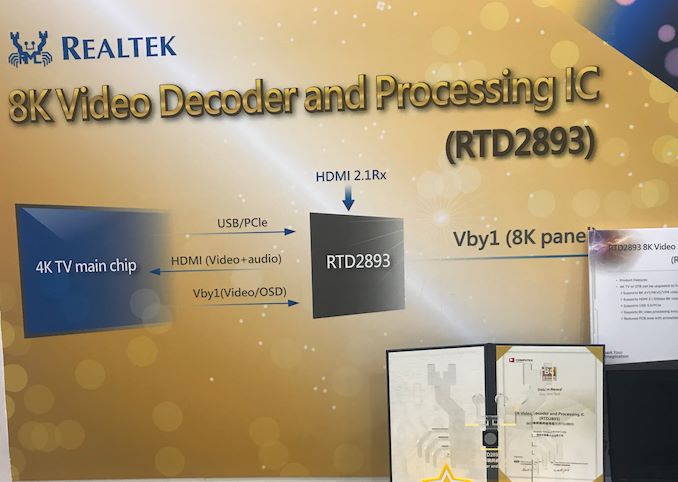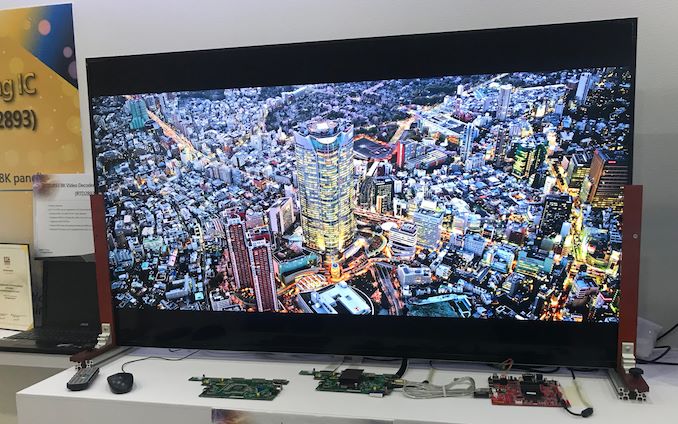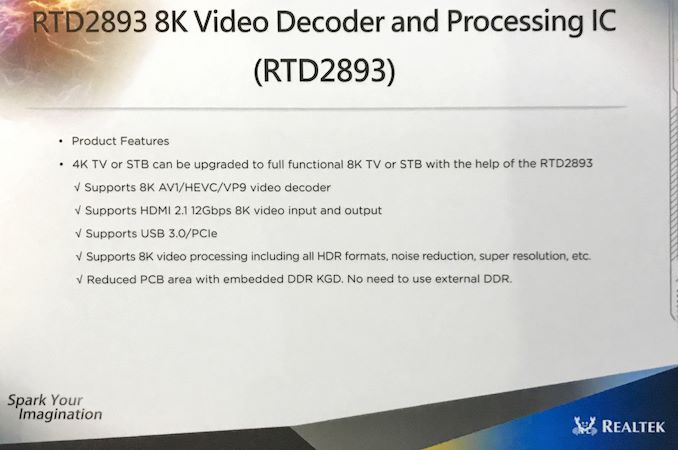Realtek Demonstrates RTD2893: A Platform for 8K Ultra HD TVs
by Anton Shilov on June 19, 2019 10:00 AM EST- Posted in
- Monitors
- Displays
- Trade Shows
- UltraHD
- Realtek
- 8K
- Computex 2019

Just like with any other major transitions, the shift to 8K Ultra HD TVs will require not only new display panels (and even new display technologies), new cables, and new media, but also new codecs as well as new SoCs. To this end, Realtek demonstrated its first platform for 8K televisions and Ultra HD set-top-boxes/players at Computex.
Realtek’s RTD2983 SoC can support decoding 8K resolution videos encoded using the AV1, HEVC, and VP9 codecs. The chip can process all HDR formats, reduce noise, upscale, and perform all the other functions common for processors for televisions and digital media players. The RTD2983 has PCIe and USB 3.0 interfaces, it can receive data via an HDMI 2.1 48 Gbps interface, and transmit pixel data over Vby1 wires. One advantage the RTD2983 has is embedded memory, which eliminates necessity to use external DRAM devices, lowering the BOM costs for finished products.
Since Ultra HD content is scarce, Realtek demonstrated the RTD2983 platform at Computex using a static picture encoded using one of the aforementioned codecs. The lack of complex motion is a bit of a letdown here, but considering how hot the SoC's heatspreader got, Realtek certainly wasn't running a light workload here.
As for consumer applications for the new chip, Realtek ultimately brought the RTD2983 to Computex to show potential customers that it's ready, and that interested parties can start designing their devices based on the SoC. Though keeping in mind long design cycles for consumer electronics, it bears noting that we won't see Realtek's new SoC show up in finished products for a while yet. But in a year or two down the line, this is likely to be one of several SoCs we'll see at the heart of various mass-market Ultra HD boxes.
| Want to keep up to date with all of our Computex 2019 Coverage? | ||||||
 Laptops |
 Hardware |
 Chips |
||||
| Follow AnandTech's breaking news here! | ||||||













23 Comments
View All Comments
eastcoast_pete - Wednesday, June 19, 2019 - link
@Anton: There is 8K video available, at least enough for demo purposes. If, as you report, a static image led to the Realtek's chipset getting quite toasty ( "...how hot the SoC's heatspreader got"), I actually doubt that they simply couldn't find a short 8K demo loop to show off their new creation. A video decoding and processing chip running hot with a static image doesn't augur well for later use with actual video. Rather, it looks like the RTD 2893 is not ready for prime time (or anything else in 8K), and the static image was all this chip can handle at this time.nathanddrews - Wednesday, June 19, 2019 - link
I think you missed the part about it not being final, but rather a demonstration of a chipset they're working on for release in 1-2 years.Santoval - Wednesday, June 19, 2019 - link
That's beside the point. The "chipset not being ready" and the mentioned "scarcity of 8K content" are two entirely distinct things.Azethoth - Thursday, June 20, 2019 - link
I think you missed the part about it not being final, but rather a demonstration of a chipset they're working on for release in 1-2 years.mode_13h - Friday, June 21, 2019 - link
Um, are you the same person that just posted as @nathanddrews? If not, you certainly share his issues. See above.B3an - Thursday, June 20, 2019 - link
"Realtek ultimately brought the RTD2983 to Computex to show potential customers that it's ready, and that interested parties can start designing their devices based on the SoC"Seems very much ready to me.
It's the actual consumer products that will not be ready for a year or two. So if this finished SoC is getting hot from simply displaying a static image, then that's just embarrassing. There's also a lot of 8K videos online if you look around, including on YouTube, so it seems as if they purposely showed a static image because they didn't want this thing melting...
levizx - Thursday, June 20, 2019 - link
There's no way they can do 8K (or even 4K) AV1 efficiently right now, it has to be using some sort of FPGA instead of the actual final IC.mode_13h - Friday, June 21, 2019 - link
That was my thought. I was surprised to see something already doing AV1 decode @ 8k.mode_13h - Friday, June 21, 2019 - link
Are you schillin', dude?1. The article clearly gave the reason as being a lack of content.
2. The article clearly stated:
"Realtek ultimately brought the RTD2983 to Computex to show potential customers that it's ready"
As for 1-2 years, that was the projected time frame in which end devices were expected to ship. Nowhere in the article did it say anything about this SoC being "not final".
This was not a long article. You've either got serious reading comprehension issues or some other kind of agenda. Either way, you lose.
Kevin G - Wednesday, June 19, 2019 - link
It depends on how it handled a static image. Many of the real time video-over-IP codecs leverage M-JPEG/M-JPEG2000. The result is a constant ~900 Mbs data stream regardless if the actual content is a still image or full motion video. The encoding algorithm is 'dumb' in this sense that it can't detect and highly compress still images while maintaining the necessary latency desired.Realtek could be leveraging a similar scenario as I described above but there is not enough detail to determine either way. This *could* be perfectly indicative of how the platform will behave with video.